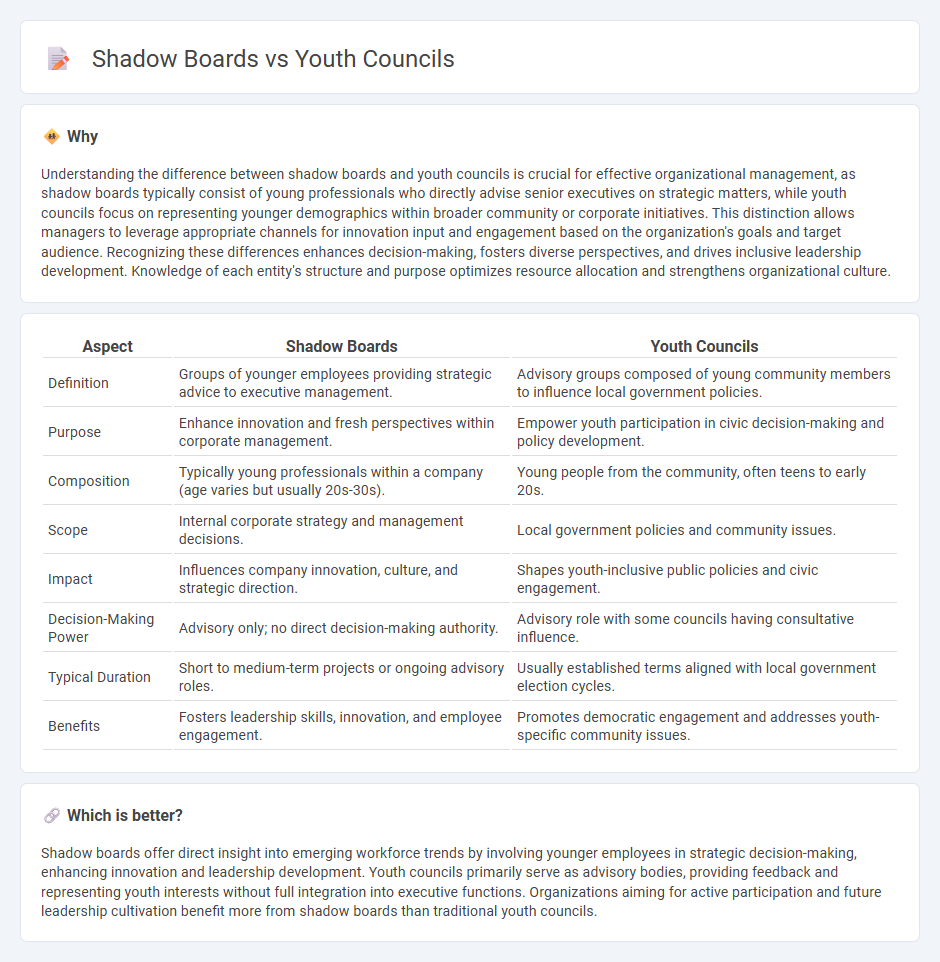
Shadow boards and youth councils empower emerging leaders by integrating fresh perspectives into organizational decision-making. Shadow boards consist of younger employees who advise top management, while youth councils focus on representing the interests and ideas of young stakeholders within a community or company. Discover how these innovative governance structures can transform leadership dynamics and drive sustainable growth.
Why it is important
Understanding the difference between shadow boards and youth councils is crucial for effective organizational management, as shadow boards typically consist of young professionals who directly advise senior executives on strategic matters, while youth councils focus on representing younger demographics within broader community or corporate initiatives. This distinction allows managers to leverage appropriate channels for innovation input and engagement based on the organization's goals and target audience. Recognizing these differences enhances decision-making, fosters diverse perspectives, and drives inclusive leadership development. Knowledge of each entity's structure and purpose optimizes resource allocation and strengthens organizational culture.
Comparison Table
| Aspect | Shadow Boards | Youth Councils |
|---|---|---|
| Definition | Groups of younger employees providing strategic advice to executive management. | Advisory groups composed of young community members to influence local government policies. |
| Purpose | Enhance innovation and fresh perspectives within corporate management. | Empower youth participation in civic decision-making and policy development. |
| Composition | Typically young professionals within a company (age varies but usually 20s-30s). | Young people from the community, often teens to early 20s. |
| Scope | Internal corporate strategy and management decisions. | Local government policies and community issues. |
| Impact | Influences company innovation, culture, and strategic direction. | Shapes youth-inclusive public policies and civic engagement. |
| Decision-Making Power | Advisory only; no direct decision-making authority. | Advisory role with some councils having consultative influence. |
| Typical Duration | Short to medium-term projects or ongoing advisory roles. | Usually established terms aligned with local government election cycles. |
| Benefits | Fosters leadership skills, innovation, and employee engagement. | Promotes democratic engagement and addresses youth-specific community issues. |
Which is better?
Shadow boards offer direct insight into emerging workforce trends by involving younger employees in strategic decision-making, enhancing innovation and leadership development. Youth councils primarily serve as advisory bodies, providing feedback and representing youth interests without full integration into executive functions. Organizations aiming for active participation and future leadership cultivation benefit more from shadow boards than traditional youth councils.
Connection
Shadow boards and youth councils both serve as strategic tools in management to involve younger generations in decision-making processes, fostering innovation and leadership development. These entities provide fresh perspectives by enabling emerging talent to influence organizational strategies, aligning with contemporary management practices that value diversity and inclusivity. Integrating shadow boards and youth councils enhances organizational agility and succession planning, ensuring sustained competitive advantage.
Key Terms
Representation
Youth councils primarily emphasize authentic representation by including young voices directly in decision-making processes, fostering engagement and empowerment within the community. Shadow boards, on the other hand, serve as advisory groups providing strategic insights from younger perspectives without direct voting power, bridging generational gaps in corporate and organizational environments. Explore how each model uniquely enhances organizational inclusivity and drives impactful youth involvement.
Decision-making
Youth councils empower young people by providing a platform to influence local policies and community projects, fostering civic engagement and leadership skills. Shadow boards consist of young professionals advising senior executives on strategic decisions, enabling organizations to harness fresh perspectives and innovative ideas for corporate growth. Explore how these models shape decision-making processes and drive impactful change in different contexts.
Empowerment
Youth councils amplify empowerment by providing young individuals with direct avenues to influence community decisions, fostering leadership and civic engagement. Shadow boards serve as strategic advisory groups, enabling emerging professionals to contribute fresh perspectives to corporate governance and decision-making processes. Discover how these frameworks uniquely foster empowerment through participatory involvement and organizational influence.
Source and External Links
Youth council - Youth councils, also known as youth cabinets or youth parliaments, are appointed or elected youth bodies engaged in community decision-making across governmental and non-governmental levels to represent and amplify young people's voices in policymaking and civic participation.
Mayor's Youth Council - The Boston Mayor's Youth Council is a citywide program that empowers 20 diverse high school students to engage in civic leadership, advise city officials, and organize youth events to influence local policies affecting young people.
National Youth Council - The American Red Cross National Youth Council is a 15-member youth group that advocates for youth volunteers, advises on youth-related policies, and organizes national campaigns and activities to engage young people in humanitarian efforts.
 dowidth.com
dowidth.com